Recipes: Herbal Preserves
Preserved lemons & Sparkling Preserved Lemonade


We have recently been making a fresh batch of preserved lemons with added herbal flavours.
They are an essential ingredient to Moroccan cuisine but add a savory umani flavour with a mellow citrus undertone to so many more dishes.
Preserved lemons are a luxury to buy but really easy to make.
Essentially fresh lemons are preserved in lots of salt with added herbs, which gives them a salty, slightly tart,
pickled flavour, with all of the flesh, pith and peel softened and edible.
You will need a suitable sterilised jar with a wide screw lid (or a preserving jar with a seal)
that will just hold the number of lemons you plan to preserve.
Cut each lemon nearly into quarters top to bottom to within 2cm of the base, leaving it attached at the bottom end.
As you transfer each lemon into the jar stuff the centre with a tablespoon of salt.
Push them in really tightly and seal up and leave initially for a week.
After this time open up the jar and press the lemons down hard to squeeze them together.
The salt will have drawn out loads of juice, add sprigs of thyme and rosemary
and a little more lemon juice to just cover the fruit if needed.
Top up the jar with 1cm of olive oil to make the lemons air tight and put the jar away in a cool dark place for at least 4 weeks.
Your preserved lemons can be added to all manner of dishes:
- Vinaigrette dressings for salad
- To pep up a lemon cake
- Add umami to a soup
- Stews and pasta sauces
- The ultra concentrated brine left over is great used sparingly in cocktails, dressings and sauces
For a refreshing treat make some Sparkling Preserved Lemonade:
- Mix together 4 tbsp finely chopped preserved lemons to 4 tbsp fresh lemon juice and 2 tbsp chopped mint.
- Divide the mixture between 4 glasses filled with ice and top up with tonic water.
- Garnish with a lemon slice, a curl of cucumber and a big sprig of mint.
Dill oil

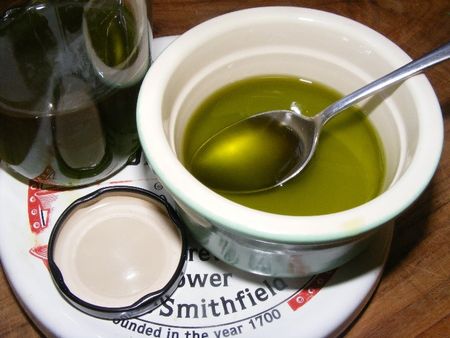
(Makes about 125ml)
Roughly chop 75 g dill and put in a food processor with
150ml mild flavoured olive oil and 1 tsp sea salt.
Whizz up until the leaves are finely chopped then transfer to a saucepan and heat until the mixture is too hot to touch but not boiling.
Allow to cool a little and filter into a small bowl or jug set in a bowl of ice, this will take an hour or so.
You can use kitchen paper to line the sieve or a new J cloth.
Transfer your dill oil to a clean sterile bottle and it will keep in the fridge for several weeks.
It may go cloudy and a little thick when it is cold but this soon clears as it warms up.
You can make several bottles and freeze to use in the winter months.
You can use this method for parsley and
chervil as well, and even perennial herb
leaves like chives and tarragon.
Coriander salsa

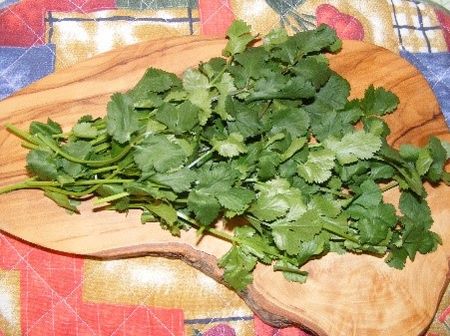
Coriander salsa is a versatile condiment to keep in the fridge and if you have a lot of the herb then freeze it in small bottles — mustard jars are an ideal size.
It's very simple to make:
- Roughly chop 3 cloves of garlic and a jalapeno pepper — remove the seeds if you don’t like too much heat.
- Remove the thicker stems from a 100g bunch of coriander and transfer to a blender / food processor with the garlic and chilli.
- Add 120 ml white wine vinegar and process to make a relatively smooth sauce. You may need to use a spatula to push the ingredients down the sides a few times as you chop.
Stored in the fridge, this makes a great accompaniment to meat and kebabs, served up with Mexican food or stirred into vegetable soups.
Horseradish Sauce

- 1 tsp lemon juice
- 1 tsp sugar
- 2 tsp vinegar
- 4 tbs grated horseradish
- 1 tsp prepared mustard
- 150ml either double cream
- or crème fraiche
- or Elmlea
- ½ tsp salt
- ¼ tsp black pepper
The peeled horseradish maybe grated by hand or ideally finely chopped enclosed in food processor
where the fumes are kept away from your eyes.
Add all the other ingredients to the horseradish either in a bowl or directly into the food processor
and blend well.
The sauce keeps well in a jar in the fridge and if Elmlea is used the sauce will keep for
up to 9 months if tightly covered, so it is worth making a large batch.
Basil Butter

A subtle alternative to the usual garlic variety.
Blend together:
- 75 g soft butter
- 2 tbs greek basil
- 1 tbls garlic chives (chopped)
- a grinding of coarse black pepper
This butter will keep well in the fridge and has many summery uses.
- Serve with grilled meat or fish.
- Dot onto tomatoes before baking.
- Spread onto french bread slices and top with grated cheese before baking for an instant snack.
Basil Oil

One of the best ways to preserve the true taste of basil for the winter months.
Those little pots of herb from the supermarket never taste quite the same as summer grown basil.
Fill a clean jar loosely with sweet basil leaves
and add extra virgin olive oil to fill.
Seal tightly and leave in a sunny windowsill, shaking every couple of days.
After two weeks store the bottle in the dark until needed, do not drain the oil off from the leaves before use.
This oil can be used in dressings and marinades throughout the winter,
and drizzled over pasta dishes to remind you of the summer warmth!
Smoky peppers with paprika, fennel and green herbs

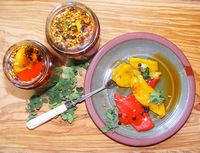
Try making some jars of our smoky peppers — they keep well in the fridge to serve with a whole variety of dishes.
Makes 2 smallish jars — depending on the size of your peppers.
- 500 ml well flavoured olive oil
- 2 cloves garlic — in thin slices
- 3 tsp smoked paprika — the sweet one not the hot type
- 1 tbsp fennel seed
- 1 tbsp peppercorns — mixed ones if possible
- 10 large red peppers
- 10 large yellow peppers
- 300 ml cider vinegar
- Chopped green herbs — we like parsley and fennel fronds, but the choice is yours
First prepare the spiced oil.
- Warm the garlic and paprika in the oil for 5 minutes but don't let it get hot enough to cook the garlic.
- Leave aside to cool.
- After an hour or so strain through a sieve lined with double thickness kitchen paper to remove the spices.
- In a small pan heat the peppercorns and fennel for just 1 minute until they smell aromatic.
- Add to the filtered oil and set aside.
Whilst the oil is cooling prepare the peppers.
- Heat the grill to high.
- Whilst it is heating cut each pepper in half lengthways through the stalk end and remove as much seed as possible.
- Spread them out on baking sheets, lined with kitchen paper for easy cleaning.
- Grill each tray for up to 15 minutes until the skins are black and then immediately transfer the peppers to plastic food bags whilst still hot.
- When the peppers are cool the skins and stalks should slip off easily, along with any remaining seeds.
- Cut them into large serving pieces – maybe 4 – 5 cm long.
- Bring the vinegar + 300ml water to simmering point and add the peppers.
- Bring back to a simmer and cook for just 3 minutes before draining well — you can discard the vinegar.
- Pack the peppers into small sterilised jars.
- Heat the spiced oil for a few minutes until just hot enough to touch.
- Pour over the peppers, along with the whole spices to cover them completely.
- Seal the jars and store in the fridge.
- Add the chopped herbs to the peppers as you serve them otherwise they will discolour.
Herbal Honey

Using honey and herbs together is a perfect combination. Making your own herb infused honey is one of my favourite ways to use flavoursome herb sprigs.
Fresh and aromatic herbs work best when infusing, allowing their essential oils and flavours to permeate into the honey. Rosemary, sage, thyme, lemon balm, lavender and chamomile all make lovely flavoured honey, either as a single variety or as combinations. Make sure the herbs are totally dry before you begin.
- Half fill a clean dry jar with leaves or small sprigs of your chosen herb and fill to about 3/4 full with
a good quality honey. - Using a chopstick or wooden skewer gently stir the herbs around until they are totally coated
in honey and all the air bubbles are released. - Top up with more honey to fill the jar and seal tightly.
- Leave to infuse in a cool dark place for at least 5 days or longer — up to 3 weeks for strongly
aromatic honey — then strain through a fine sieve into a clean jar and label ready for use.
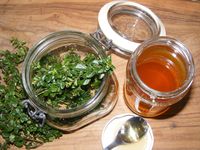
N.B. Lemon balm should have no more than 1 day infusing, that way you will get the lovely lemony taste without the strong tannins which will be gradually extracted later.
Keep the herb sprigs to make a herb tea or tisane.
The aromatic honey makes an ideal condiment and can be used in all manner of cooking and home baking. Try adding to salad dressings and marinades for a subtle herbal flavour, use it to sweeten drinks like lemonade and add to fizzy water to make a refreshing herby drink.
Some herbs like thyme, sage and rosemary are strongly medicinal.
A spoonful of sage honey will soothe a sore throat and thyme honey will help with a cough.
Orange and Redcurrant Confit

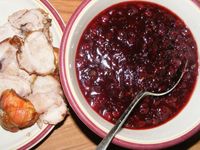
Makes a smallish jar.
- 500 g redcurrants — with their stalks removed
- 1 tsp olive oil
- 1 finely chopped onion
- 1 large orange
- 3 tbsp finely chopped orange mint
- 3 heaped tbsp sugar
- 150 ml white wine
- 3 tbsp white wine vinegar
- salt and black pepper to taste
Gently fry the onion in the oil for 5 minutes or so until it softens but does not brown.
Add the zest of the orange and its juice and half of the mint, reserving the other half to add at the end.
Add all of the other ingredients and simmer uncovered on a moderate to low heat for about an hour.
Keep an eye on the pan and give it a stir every 10 minutes or so.
The confit is ready when the juice has reduced to leave just a little in the bottom of the pan.
Taste at this point and if you prefer a sweeter relish then stir in extra sugar a spoon at a time.
Stir in the remaining mint and leave to cool before serving.
Once cool any extra can be frozen to use in the future.
Oregano Pesto

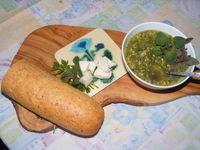
Oregano makes a great pesto, a lovely spring taste to stir through pasta or to serve with grilled fish.
- 30 g chopped fresh oregano leaves —
this is about a large cup full - 2 cloves of garlic
- 40 g flaked almonds
- 100 ml olive oil
- 1 tbs lemon juice
- Salt and freshly ground black pepper to taste
Put the oregano, garlic and nuts into a blender or food processor,
chop lightly then add half of the olive oil with the lemon juice and blend to a coarse paste —
not too fine — you need to be able to distinguish
the tiny pieces of leaf.
Stir in the rest of the olive oil and some seasoning to taste.
A mix of oregano and parsley leaves also gives a delicious flavour.
Try using our new Italian parsley which will be available to buy on our website in a few days time.
- Stir 2 tablespoons of your pesto through pasta for 2 people.
- It goes well with lightly cooked vegetables such as courgettes, carrots and beans.
- Mix with roasted vegetables such as a mix of aubergine, peppers and courgettes.
- Spread onto savoury crackers or a baguette and top with some goats cheese.
- Serve with any grilled or pan fried fish.
- I’m sure that you’ll have plenty of ideas of your own!
As you can see oregano is especially versatile and the flavour mingles well with many different types of food.
Pesto Sauce

- 50g basil leaves of any type
- 1 large clove of garlic, peeled
- 1 tbls pine kernels
- 6 tbs olive oil
- 25g parmesan cheese, grated
- salt to taste
Put all the ingredients except the cheese into the processor and pulse until you have a smooth mixture.
Do not overblend, try and leave tiny but distinguishable leaf pieces in the final mixture.
Spoon into a bowl and stir in the cheese and extra salt if required.
Pesto keeps for several days in the fridge in small containers,
cover the surface with a thin layer of oil before covering tightly.
It can also be frozen to use in the winter.
Parsley and
wild rocket can also be used to make excellent and unusual pestos.
Simply replace the basil with the herb of your choice.
When using rocket leaves hazelnuts can be used instead of pinenuts.
Shiso Pesto

- 40 large shiso leaves
- 100g rocket (wild or salad variety)
- 40g almonds – coarsely chopped
- 1 clove of garlic
- 100ml olive oil (or less if you prefer)
- Salt as seasoning.
Blitz all the ingredients except the salt in a food processor,
scrape the leaves down the sides as you go to get an even paste.
Try and stop processing before the pieces of leaf lose all identity, don't let it become a smooth paste.
Season with salt if you wish and transfer to a small bowl.
The pesto will keep well in the fridge for a day or so if you cover with a cm of oil.
Try experimenting with the quantities of shiso and rocket,
and also the addition of lemon juice to get some varying flavours!
Mint and Apple Jelly

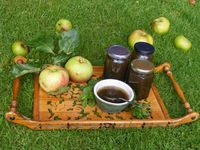
Apples and mint are a delicious combination.
Mint and apple jelly
is both sweet and savoury and goes especially well with lamb
and also with roast pork and chicken.
Mint does lose its colour
with prolonged cooking,
you may if you wish add a few drops
of green food colouring before bottling, either way it is still delicious.
Makes 2 –3 jars
- 1 kg cooking apples
- 1 litre of water
- 6 sprigs of mint
- 50 g mint leaves — we like garden mint but do experiment
- 800 g sugar or maybe a little more
Coarsely chop the apples and put into a large pan with the sprigs of mint and 750 ml of the water.
Cook gently over a low heat until the apples are soft and fluffy. Leave to cool for 30 minutes.
Tip the apple pulp into a muslin bag and suspend over a bowl to drip.
You can use a fine sieve
if you don’t have a bag.
Leave as long as possible — overnight is best for maximum juice extraction -
gently move
the bag from side to side to speed up the juice dripping
but try not to squeeze as this makes
the jelly very cloudy.
Once the pulp in the bag is quite dry, put the remaining 250 ml of water in a pan and
add the 50 g of mint — finely chopped. Bring to the boil and then remove from the heat immediately.
Pour the mint and its water into a measuring jug and add the apple juice.
For each 100 ml of liquid
you will need 80 g of sugar, so for 1 litre you will need 800 g.
Put the minty apple juice into a large pan with the appropriate amount of sugar
and boil
on a medium heat until it reaches setting point, this will take about 40 minutes.
Keep a chilled saucer in the fridge and check periodically by putting a teaspoonful of the jelly
onto the cold saucer to see if it thickens and forms skin.
Pour into warmed sterilised jars.
Preserving Alpine Strawberries

The scarlet alpine strawberries
make an elegant decoration to all types of desserts and also summer drinks such as Pimms.
To preserve the flavour for the winter months the berries can be infused in vodka.
Half fill a jar with the fruit and add a little sugar to taste if desired.
Top up with vodka and keep for several weeks in a dark place, shaking every so often.
The fruit will soon lose its colour and flavour to the spirit
and can be drained off when the strawberries are greyish in colour.
The flavoured vodka can be used in desserts in the winter months or served as a liqueur.
Tarragon Vinegar

Place 8 heaped tablespoons of tarragon leaves
into a pestle and mortar and bruise lightly.
Place in a screw capped jar or wide mouthed bottle and pour over 500 ml white wine or cider vinegar.
Leave in a cool dark place for 2 – 3 weeks whilst the tarragon flavours the vinegar.
Drain the flavoured vinegar off from the leaves and then pour back into the bottle
with a fresh whole sprig of tarragon added for extra flavour and decoration.
Basil Oil

One of the best ways to preserve the true taste of basil for the winter months.
Those little pots of herb from the supermarket never taste quite the same as summer grown basil.
Fill a clean jar loosely with sweet basil leaves
and add extra virgin olive oil to fill.
Seal tightly and leave in a sunny windowsill, shaking every couple of days.
After two weeks store the bottle in the dark until needed, do not drain the oil off from the leaves before use.
This oil can be used in dressings and marinades throughout the winter,
and drizzled over pasta dishes to remind you of the summer warmth!